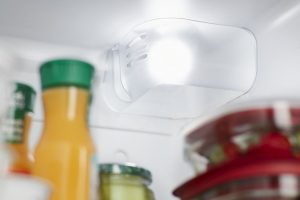What are the Causes?
- The freezer unit is too cold, and this is directing excessive volumes of cold air into the connected refrigerator food storage space.
- The refrigerator is set on the coldest temperature setting due to a mistake or it has been moved accidentally.
- There is not enough food in the refrigerator and/or the air is not circulating properly.
- The door seals have failed, or they are failing.
- The refrigerator temperature is set too high deliberately.
- The condenser coils are dirty or failing, and they need to be cleaned or replaced.
Examining the Possible Causes in More Detail
To better understand the impact of these possible refrigerator freezing problems, let’s examine four of these causes in more detail:
1. The Temperature Setting
The dial installed on many refrigerators can be confusing because it’s often a simple 1-5 number range. Better refrigerators have a built-in display with a thermostat, and yet this can still be inaccurate. If you have a simple thermostat dial, it’s important to understand that the highest number is the coldest and the lower numbers are warmer. This could be considered to be counterintuitive, and it can cause people to set the wrong temperatures. If you’re struggling to set an accurate temperature, it’s a good idea to invest in a separate thermostat that you can place in the refrigerator and freezer sections.
2. The Freezer Section
Many people don’t know that the freezer section can affect the performance of the refrigerator. This is more likely if the refrigerator has a freezer section at the base of the appliance. Adding the aforementioned thermostat to the freezer can help you to monitor the temperatures accurately. The freezer should be kept as close to 0ºF as possible, and colder settings can lower the temperature in the refrigerator too. When you make temperature adjustments, they should be incremental, and time should be allowed to monitor the results. If you reach the stage where the food in the refrigerator is no longer frozen, the problem has been solved.
3. Food Storage Issues
If there is too much food in the refrigerator, it may not cool properly because the airflow is restricted. But, the opposite is true; too little food and the refrigerator may freeze, which leads to early spoilage. Avoid placing food too close to the air vent, back, and sides of the refrigerator. Leave a ½” gap between food items to promote airflow, and check or double check the temperature periodically with a separate thermostat.
4. Faulty or Dirty Condenser Coils
The condenser coils are usually located under or at the rear of the refrigerator, and they are prone to dust and dirt accumulation. Locate the grill, and if it’s dirty, it can be cleaned with a brush or vacuum cleaner. Wait a few hours; if the food is still frozen, it’s likely that a replacement condenser coil is needed.
There are many options for appliance installations, and learning about your options will help you to get the maximum functionality and enjoyment from your new appliance. For practical guidance and advice, you can rely on our professional home appliance installers to help you with installations and repairs.
